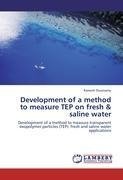
-
 Anglický jazyk
Anglický jazyk
Development of a method to measure TEP on fresh & saline water
Autor: Ramesh Duraisamy
The ubiquitous presence of transparent exopolymer particles (TEP) in various water sources of membrane-based treatment plants and their ability to adhere to surfaces (high stickiness) and to initiate biofilm formation have led some experts to suggest that... Viac o knihe
Na objednávku, dodanie 2-4 týždne
45.36 €
bežná cena: 50.40 €
O knihe
The ubiquitous presence of transparent exopolymer particles (TEP) in various water sources of membrane-based treatment plants and their ability to adhere to surfaces (high stickiness) and to initiate biofilm formation have led some experts to suggest that TEP may have a major role in organic and biological fouling of membrane systems. This paper aims discuss the latest knowledge on the possible link of TEP to membrane fouling, assess the currently available techniques to identify/measure TEP and how this can be applied in membrane fouling studies. Staining with Alcian blue is so far the most feasible way to assess TEP in water and in fouled membrane samples. Alcian blue was found to react specifically with acidic polysaccharides based on tests with model polysaccharides (neutral and anionic) and protein substances at pH 2.5. Under this condition, the relative concentration of TEP in water can be measured spectrophotometrically at 787 nm wavelength. The current TEP method is also an indirect measure of anion density of TEP, an indication of how surface-active and sticky these substances are; thus, a good indicator of their fouling potential in membrane systems.
- Vydavateľstvo: LAP LAMBERT Academic Publishing
- Rok vydania: 2011
- Formát: Paperback
- Rozmer: 220 x 150 mm
- Jazyk: Anglický jazyk
- ISBN: 9783846502693







 Nemecký jazyk
Nemecký jazyk 




